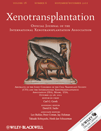Transplantation of human cells in the peritoneal cavity of immunodeficient mice for rapid assays of hepatitis B virus replication
Abstract
Kumar M, Bandi S, Cheng K, Gupta S. Transplantation of human cells in the peritoneal cavity of immunodeficient mice for rapid assays of hepatitis B virus replication. Xenotransplantation 2011; 18: 380–389. © 2011 John Wiley & Sons A/S.
Abstract: Background: Studies of natural hepatitis B virus infection must be restricted to humans or primates due to viral species-specificity. Alternative hepadnavirus animal models, e.g., woodchuck hepatitis virus in captive woodchucks, are not convenient, while in transgenic mice hepatitis B virus or viral proteins are expressed permanently through integrated genomes. Availability of small animal models that are easily produced and permit rapid assays will be quite helpful.
Aims: We examined whether transplantation of human cells in the peritoneal cavity of mice will generate an appropriate mass of cells with hepatitis B virus replication.
Methods: HepG2 2.2.15 cells were transplanted intraperitoneally into NOD/SCID mice. Replication of hepatitis B virus and viral gene expression was determined by analysis of blood and transplanted tissues with viral DNA and hepatitis B core antigen expression. Interruption of viral replication was examined.
Results: After intraperitoneal transplantation with microcarrier scaffolds, 2.2.15 cells engrafted and proliferated in the peritoneal cavity of NOD/SCID mice. Hepatitis B virus replicated in transplanted 2.2.15 cells as shown by hepatitis B core antigen expression. Moreover, viral particles were secreted into the blood. Hepatitis B virus replication was susceptible to conventional antiviral drug therapy, such as lamivudine, as well as experimental antiviral gene therapy with a synthetic mimic of an antiviral cellular microRNA.
Conclusions: Intraperitoneal transplantation of human cells rapidly provided reservoirs of hepatitis B virus in mice. This simple xenotransplantation approach will be effective and convenient for studies of hepatitis B and other human viruses in vivo.




